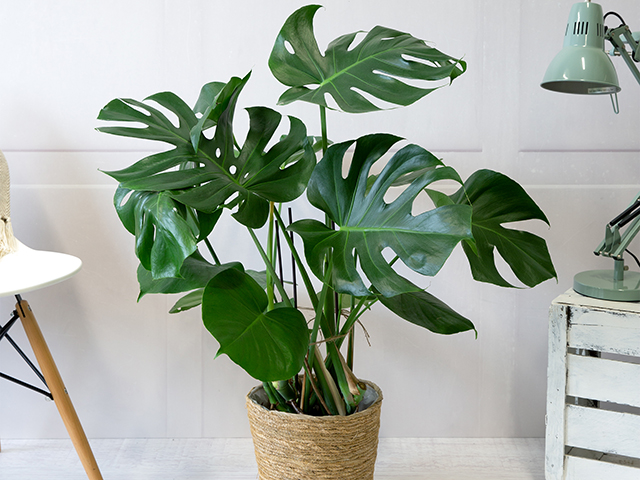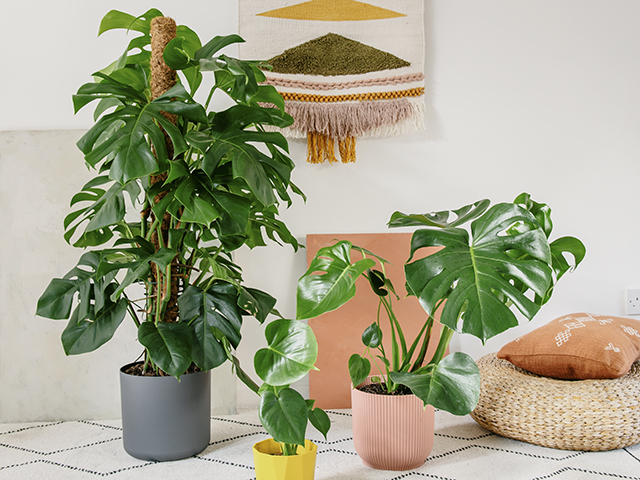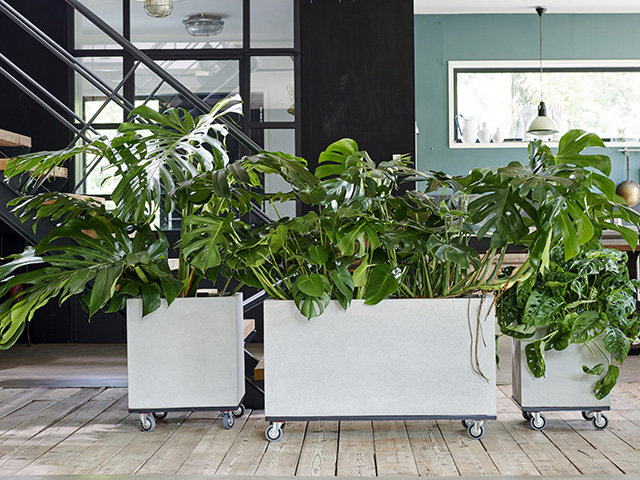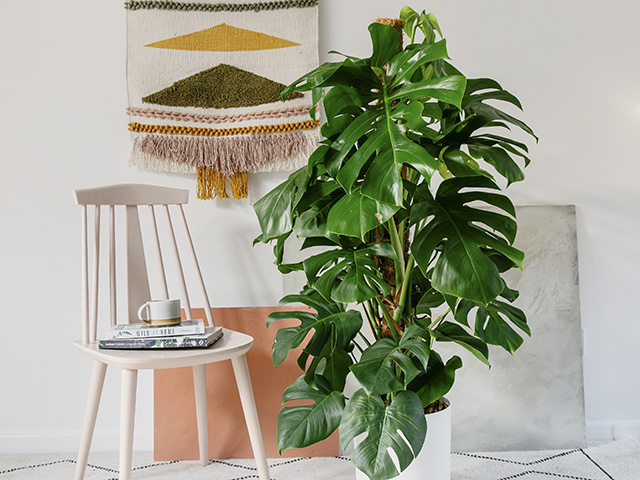
Styling Elize Eveleens - Klimprodukties
Cheese plants: The ultimate care guide for Monstera
Whether you know them as Swiss cheese plants or prefer the latin Monstera Deliciosa, we’ve created the ultimate care guide for these much-loved houseplants.
This feature may include affiliate links, from which we earn a commission.

Image: Bunches
The symbol of the millennial houseplant phenomenon, cheese plants, or Monstera Deliciosa as they are officially known, are a new indoor favourite after first becoming popular in the UK in the 1970s.
They bring much-needed green goodness to any home and when looked after properly, will thrive!
Keep scrolling for everything you need to know about them…
How to look after a cheese plant
If you find the right spot in your home for your cheese plants, they’re pretty low maintenance. If not, they probably won’t thrive! Just like anything, it’s important to invest a bit of time in your houseplants to get the results you want.
Jo Lambell, founder of houseplant delivery company Beards & Daisies told us: ‘Cheese plants are incredibly popular and easily recognisable for their big, holey leaves. They’re easy to care for so ideal for those new to plant parenthood.
‘It’s important to pay attention to their leaves and make sure they’re luscious and green by wiping them down with a damp cloth to keep them dust-free and helping them to breathe. As these plants are native to the tropics of north and south America, they also appreciate a misting of lukewarm water to keep their humidity levels high.’
Read more: 7 houseplant care tips for beginners
What conditions are best for cheese plants?
‘They love bright, indirect light and make sure you only water them when the top two inches of soil feel dry to touch.” Jo shares. “Monstera need plenty of space and benefit from some support, such as a moss pole, as they grow larger. Try to regularly rotate your plant to ensure even growth, too.’
Claire Bishop, houseplant buyer at Dobbies Garden Centres agrees. “Where possible it’s best to try and mimic the tropical environment cheese plants originate from. They are used to speckled light on the rainforest floor so, place them in an area of indirect light and create a warm, humid environment.
‘Cheese plants also prefer well-draining soil, as if it retains too much water your plant will be at risk of root rot. They naturally grow and climb but you can rein them in if they get too leggy by pruning, this ensures they won’t take over your house! Cut the back stems that are producing few or no leaves, this will encourage healthy growth in the rest of the plant and also helps to train the direction of growth in the plant.’

Image: Beards & Daisies
Can you grow cheese plants outdoors?
As a bigger plant, many people would love to know if they could keep them in their outdoor jungle to enable them to reach their full size but unfortunately, in the UK at least, it simply isn’t possible. ‘As the cheese plant hails from the rainforest, the warm and humid conditions will simply not compare with the bleak and rainy ones we’re used to in the UK so it’s best to keep your plant inside,’ Jo tells us.
Which rooms are best for cheese plants?
‘It’s best to keep your plant inside where it is sheltered and can be easily kept warm, your bedroom, home office, and living room are all ideal places for a cheese plant to thrive. You could even make the most of the steamy conditions of your shower by keeping it in your bathroom if you have the space!’
Claire agrees, adding: ‘Bathrooms can be wonderful for cheese plants, but if you have central heating in your home or it’s particularly dry, give your plant a special treat by misting it in the morning with water. It will definitely thank you for it and you’ll be rewarded with a longer plant life!’
Read more: Trending: 5 of the most popular houseplants for your home
How big do cheese plants get?
While it entirely depends on how well you look after them, Claire has some advice on that score.
‘In the wild, cheese plants can grow up to 60 feet and sometimes even higher! However, they can come in apartment-friendly sizes, so can be grown small or big to fit whatever you’d prefer in your home. It is an epiphyte which means it naturally grows by climbing trees, so when grown indoors, it’s best to give it some support with a moss pole.’
Are cheese plants poisonous to animals?
The question many of us want to know when buying a plant – is it pet-friendly? As so many of us houseplant lovers are also animal lovers, this can be make or break for a new member of our plant family.
Claire has the answers: ‘Cheeseplants are poisonous if eaten, in fact most none-native plant species are toxic to pets, so we recommend keeping them out of the way of your animals and out of reach to alleviate the risks.’
We suggest keeping it somewhere your furry friends won’t get to. If you’re too concerned however, it might be worth investing in a non-toxic plant instead.
Read more: Which of these common houseplants are toxic?
How often do cheese plants need to be watered?
The burning question – how many of us have left a plant while we’ve gone on a two week holiday and then returned to find it brown, wilted and unsalvageable?
‘Cheeseplants like damp soil and do require moderate levels of watering. It’s not recommended to let it fully dry out as it will start to wilt. You can water sparingly weekly but ensure any excess water drains away,’ Claire tells us.
She continues: ‘Make sure you assess the plants watering needs first before giving it a drink, do this by putting your finger into the soil to assess the dryness level. If the soil is dry to a depth of one to two inches, then give it a drink. Reduce the watering in the winter months as the cooler air will help to keep it moist.’
Moral of the story? Rope in a fellow plant lover to water it during your next holiday and make sure they’re trained up to check the soil!

Image: Flower Council
Why do cheese plants drip water?
Many of us have wondered this, is it overwatering? Or is it related to something else? Claire has the answers: ‘This is a completely natural process, plants weep in the same way that humans sweat, to get rid of excess water and any nutrients that they don’t need. If a plant takes too much water, however, or needs to get rid of toxins, it will produce sap which is known as guttation.’
So what is guttation? Known as the process of an organism exuding sap through pores known as hydathodes onto the tips of its leaves. It happens due to a build up of pressure in the roots of the plant when there is too much moisture in the soil.
What makes them go yellow or brown?
Brown leaves are usually caused by dryness and this is a result of direct sunlight or central heating, whereas yellow leaves can mean your plant needs food or that it is being overwatered.
Thankfully, cheese plants rarely get pests and diseases but there are sprays available if you have any concerns. Ensuring you regularly wipe the leaves with a link-free damp cloth can help prevent issues and ensure healthy growth.
How do cheese plants get their holes?
The beautiful holes in the leaves are one of the most distinguishable parts of a cheese plant, so how do they get them? Jo at Beards & Daisies has the answer to this one: ‘Plants are really clever beings, and the cheese plant is no exception! As an epiphyte, it grows in the crevices of trees and purposely produces the holes in its foilage so that the leaves at the bottom can get access to light. The process is called fenestration, and really shows just how genius plants can be!’

Image: Beards & Daisies
Where can I buy one from?
You can pick up a cheese plant from most garden centres and DIY stores. If you’re concerned about venturing out to pick yours up during the national lockdown, you can also order them online! Beards & Daisies sell Monstera Deliciosa, Monstera Adansonii and Monstera Minima in sizes small, medium and large, and you can even get them on a moss pole so you’re already set up to help with their growth. Beards & Daisies deliver direct to your door and will even deliver your cheese plant the next day if you can’t wait!
Read more: Where to buy houseplants online during lockdown
Do you love plant life? Listen to the Dobbies gardening podcast for more expert advice and houseplant trend insights.
Have you bought a cheese plant recently? Let us know how you’re getting on with it by tweeting us @goodhomesmag or sharing a photo with us on Facebook
RELATED ARTICLES
How to create a productive workspace with houseplants





